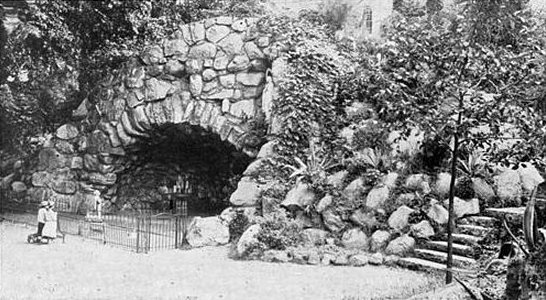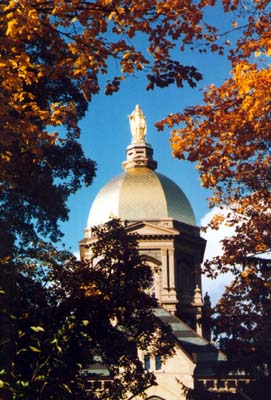
Notre Dame's Grotto / by Dorothy V. Corson


Notre Dame and Our Lady of Lourdes
From the day Rev. Edward F. Sorin, founder of Notre Dame du Lac, embarked from Le Havre, France, bound for his mission in the New World, Mary, the Mother of God, was his guiding star.
He relates with wonderment how he found the intimation of her will in the date of the departure of the first colony bound for Indiana on August 5, 1841.
But on the day of our departure, when I opened my new Breviary for vespers, . . . I was struck to see that we were starting on a beautiful festival day of the Blessed Virgin, Our Lady of Snows. The impression I received from the happy coincidence was not to be soon obliterated. I had absolutely nothing to do with the choice of the day. How often have I not thanked her since, for choosing it Herself, as a proof that she wished us to leave for our new Mission under her maternal protection.(4)
Even the visionary Father Sorin, could not have envisioned how unerringly she would guide his footsteps to the birthplace of the future University of Notre Dame. Nor could he have imagined how many ways he would find to honor her in the future.
He chose her as patroness of his greatest undertaking, the University itself, and he named the place Notre Dame du Lac, Our Lady of the Lake. And he did not stop until he had her golden statue raised on high looking down over one of the greatest shrines to her anywhere in the New World.
Devotion to Our Lady at Notre Dame was also influenced by something else that took place very early in its history. . . . Word reached the campus of something new and hard to believe that was happening in France. A peasant girl in the mountains claimed to have been visited by the Blessed Mother. . . . Both civil and Church officials were irritated at the affair, for they could see no good reason why such a thing should happen to a girl like Bernadette Soubirous, and many refused to believe.
Across the ocean, however, Notre Dame believed, perhaps because its growth seemed close to miraculous itself. The story of Bernadette's lowliness, poverty and faith were in keeping with its own. It was really the same story: what Our Lady was doing by signs and cures in France, she was working more quietly in America.
Our Lady of Lourdes was quickly accepted at Notre Dame, and honor to her under this title became the dominant Marian devotion on the campus. . . .(5)
The culmination of this early Marian devotion can be seen today in Notre Dame's stone grotto, patterned as closely as possible after the one where Our Lady appeared to Bernadette. This replica of the original Grotto of Our Lady in Lourdes, France, has become a favorite devotional spot on campus. People of all faiths have found rest and peace in this place of quiet reflection; the beauty of its natural setting, the soft candleglow, convey a feeling of warmth and welcome. No tour of Notre Dame would be complete without a visit to this peaceful shrine nestled among the trees in the shadow of the Golden Dome.
 Father Sorin's lifelong confidence in Mary's maternal protection is exemplified in this incident that happened two years before his death in 1893. He was very ill, confined to his rooms in the presbytery:
Father Sorin's lifelong confidence in Mary's maternal protection is exemplified in this incident that happened two years before his death in 1893. He was very ill, confined to his rooms in the presbytery:
As he lay in his reclining chair he could turn his head and see, through the window, the golden dome and Our Lady surmounting it. He scribbled a note in his shaky hand and addressed it to Father Thomas Walsh, C.S.C., the then president of the University. "This morning, I have been looking at Our Lady. I am now as certain as it is possible to be certain that with the aid of Our Blessed Mother, under whose image we are living, our University will prosper. . . ." (6)
When the youthful Rev. Edward F. Sorin left France bound for America in 1841, he brought with him his own boundless energy and resourcefulness, but above all, his steadfast confidence in Mary and her maternal guidance.